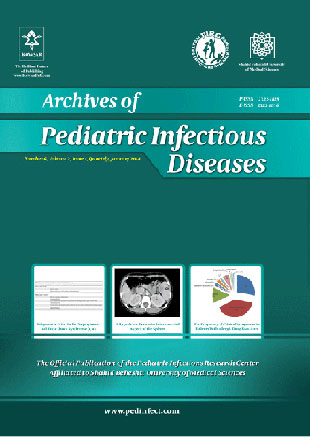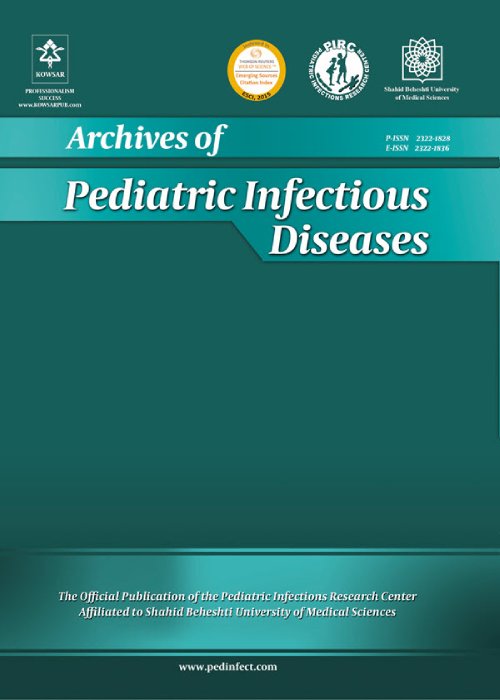فهرست مطالب

Archives of Pediatric Infectious Diseases
Volume:2 Issue: 1, Jan 2014
- تاریخ انتشار: 1392/10/11
- تعداد عناوین: 10
-
-
Page 14202BackgroundIt has been suggested that Helicobacter pylori infection might reduce the risk of atopic conditions, such as asthma, in childhood. This risk reduction could relate to the “hygiene hypothesis” which proposes an association between childhood exposure to microbes and risk of atopy..ObjectivesTo examine the association between Hp infection and childhood acquired asthma in Sardinia.. Patients andMethodsChildren from Northern Sardinia who were between the ages of 10 months to 6 years and were screened for Hp infection in 1994-1995 using IgG serology, were asked in 2012, whether they had developed asthma and/or allergic disease in pediatric age, using the global initiative on asthma guidelines questionnaire..ResultsA total of 64 children participated in the study. The sero-positivity for Hp infection was 14.1%. Eleven (17.2%) children had a confirmed diagnosis of asthma with onset before the age of 5 years, 85.9% were Hp negative and 14.1% Hp positive. Eight children of the 53 without asthma were Hp positive (15%) compare to one children positive for the infection of the 11 patients (0.09%) with asthma (8/53 vs. 1/11; P = 0.6). The majority of children (73%) were from urban areas and 43.8% had a family history of asthma or allergies. Multiple logistic regression analysis was not able to find a studied variable, including Hp infection, significantly associated with pediatric asthma..ConclusionsOur results speak against Hp infection itself playing a role to protect from the risk to develop childhood asthma although household hygiene was not directly assessed..Keywords: Child, Asthma, Helicobacter pylori
-
Page 14290BackgroundAdverse drug reactions (ADRs) occur in 10-20% of hospitalized patients and approximately 7% of general population. Drug-induced allergic reactions can affect numerous organ systems and manifest in a variety of reactions..ObjectivesThis study was designed to describe the frequency of different types of allergic drug reactions and uncover culprit drugs..Patients andMethodsAll patients who had been admitted to Mofid Children’s Hospital, Tehran, Iran due to drug reactions during April 2009 to April 2010 were included in this study. Patients who fulfilled the criteria for an allergic drug reaction according to Gell and Coombs classification, were enrolled in the study and patients with ADRs whose symptoms were not compatible with allergic reactions, were excluded from the study. An immunologist and allergist diagnosed drug allergy. A complete questionnaire was filled out for each patient..ResultsA total number of 117 patients were evaluated for adverse drug reactions, among them, 97 (82.9%) were considered to have immunological drug reactions. The most common symptoms of allergic drug reactions were morbilliform eruptions, serum sickness, DRESS (drug rash with eosinophilia and systemic symptoms), and toxic epidermal necrolysis. In 62 patients, anticonvulsant drugs had the prominent role and the most important anticonvulsants were phenobarbital, lamotrigin, and valproic acid. In 52 patients, antibiotics were found culprit and the most common antibiotics were cefixime, co-trimoxazole, and furazolidone..ConclusionsWe found that delayed types of allergic drug reactions, as well as morbilliform skin eruptions, were the most frequent presentations among our patients. Anticonvulsants were identified as the first cause in the majority of drug reactions. These medications should only be prescribed when necessary and the patients should be informed about adverse reactions. This study provides a background for more extensive studies in this regard..Keywords: Drug Hypersensitivities, Allergy, Immunology, Drug
-
Page 14672Toxic shock syndrome in children following infection with influenza is a very rare syndrome. If it is not diagnosed quickly, it may cause significant morbidity and mortality. For diagnosis of toxic shock syndrome, clinical and laboratory criteria are used. Our patient is a 3.5-year old boy who admitted to the hospital with high fever, weakness, toxicity, hypotension and skin rash due to influenza-like Illness (fever, pharyngitis, rhinitis and non-productive cough) associated with gastrointestinal symptoms, elevated liver enzymes levels, low platelet count and mucosal hyperemia. After the treatment, he recovered and was discharged from the hospital in good condition, but had mild scaling on the soles of the feet and between toes. To our knowledge, this is the first reported case in a young child. There is not any specific diagnostic test for toxic shock syndrome diagnosis, and the diagnosis is based on clinical and laboratory findings. Therefore, the early detection and treatment of the condition is very important because delay in treatment leads to increased mortality and morbidity..Keywords: Toxic shock syndrome, Influenza, Staphylococcus aureus
-
Page 15294BackgroundHelicobacter pylori is a common cause of chronic infection in human beings. The infection has universal prevalence and contracts all age groups. Probably, these bacteria are the cause of the most common chronic bacterial infection in man and have infected approximately half of the world population. The urease of these bacteria degrades the urea in stomach’s mucosa to ammoniac which results pH increment of the stomach lumen. This may allow the pathogenic intestinal protozoa to take the opportunity to cross through stomach’s decreased pH situation and cause the disease..ObjectivesThe current study aimed to evaluate the prevalence of parasitic infections (such as giardiasis) in children with Helicobacter pylori infection in Ilam city..Patients andMethodsFollowing the sample collection during 12 months from children in Ilam (Ilam, Iran), Helicobacter pylori infection was determined based on stool antigen analysis (HPSA) by enzyme-linked immunosorbent assay (ELISA) method in children who had recurrent abdominal pain. Stool specimens were examined by the direct examination and spontaneous sedimentation method to detect both trophozoite and cyst of parasites..ResultIn this study 37 children with H. pylori infection were evaluated, and the patients with positive results for Giardia lamblia, and Entamoebahistolytica/dispar were found 29.7%, and 10.8% respectively..ConclusionsThe results of the current study suggest that H. pylori infection may provide favorable conditions for Giardiasis infection, but this presumption needs to be investigated further with more samples..Keywords: Helicobacter pylori, Infection, Parasitic Diseases
-
Page 15439BackgroundMetallo-beta-lactamase (MBL)-producing Acinetobacter baumannii is a growing therapeutic concern, worldwide..ObjectivesThe aim of this study was to determine the frequency of SPM and IMP type genes among A. baumannii isolates from hospitalized patients in Loghman Hakim and Milad hospitals, Tehran-Iran from 2012 to 2013..Patients andMethodsThis study was conducted on 108 A. baumannii isolates collected from two hospitals in Tehran, Iran. Antibiotic susceptibility tests were performed by Kirby-Bauer disc diffusion and Broth microdilution methods according to clinical laboratory standards institute (CLSI) guidelines, and combined disk diffusion test (CDDT) was performed for identification of metallo-beta-lactamases (MBLs). The blaIMP and blaSPM genes were detected by PCR and sequencing methods..ResultsThe resistance of A. baumannii isolates against tested antibiotics were as follow: 108 (100%) to cefotaxime, 103 (95.4%) to ceftazidime, 99 (91.7%) to meropenem, 99 (91.7%) to imipenem, 44 (40.7%) to gentamicin, 87 (80.6%) to amikacin, 100 (92.6%) to ciprofloxacin, 105 (95.7%) to cefepime, 105 (97.2%) to piperacillin, 103 (95.4%) to piperacillin/tazobactam, 106 (98.1%) to ampicillin/sulbactam, 106 (98.1%) to co-trimoxazole, 87 (80.6%) to tetracycline and 1 (1.8%) to colistin. Using combined disk diffusion test, it was found that out of 99 imipenem non-susceptible A. baumannii strains, 86 (86.86%) were MBL producers. The prevalence of IMP-1 gene among metallo-beta-lactamase-producing A. baumannii isolates was 3 of 86 (3.48%)..ConclusionsThe prevalence of metallo-beta-lactamase-producing A. baumannii strains detected in this study is of great concern and highlights the need of infection control measures including antibacterial management and prompt identification of beta-lactamase-producing isolates..Keywords: Acinetobacter baumannii, Drug Resistance, blaIMP, 1
-
Page 16210BackgroundInfectious diseases are important causes of mortality and morbidity in children and have been a particular concern in pediatrics’ wards. Although, infectious disease are important components of population health in high-income nations, but are often overlooked. The recognition of the factors and infectious agent subtypes could help to prevent further interventions. Up to now, there are limited investigations regarding this important issue..ObjectivesWe aimed to investigate the pattern of infection in patients admitted to 17th Shahrivar Children''s Hospital..Patients andMethodsThis is a descriptive cross-sectional study which was conducted in 17th Shahrivar Children''s Hospital during August 2008-August 2009. Participants comprised of children aged 1 month to 14 years, who admitted to the hospital. Samples were collected by simple sampling and data were collected by a form including the age, gender, place of inhabitants, season of admission, duration of hospitalization and final diagnosis. Descriptive statistics such as mean, standard deviation, frequency, the maximum and minimum of data were used to analyze the results using SPSS version 16 software..ResultsDuring the study, 4676children, aged 1 month to 14 years were admitted and 29% (1357) of them were diagnosed with infectious disorders, 1127 infected patients (83.2%) were younger than 5 years. Results demonstrated that the infectious diseases were more frequent in male, winter and residents from urban area. Also, Respiratory tract and gastrointestinal infections had been diagnosed in 40.1% and 37.2% of cases, respectively..ConclusionsSince, there are few relevant studies in our country, recent studies on infectious diseases could be used for national planning and medical requirements’ preparation, it seems that periodical assessments of these diseases are mandatory..Keywords: Admission Pattern, Children, Infectious Diseases
-
Page 16471Here, we report on a ten-year-old girl with chronic draining nonhealing ulcer in her neck and unilateral cervical chronic lymphadenopathy. Her ulcer had poor clinical response to broad spectrum antibiotics and anti-tuberculosis treatment. She had undergone several wound biopsies with no conclusive results. She was otherwise healthy with no known underlying disease. Final wound excisional biopsy with specific immunohistochemistry (IHC) staining confirmed her diagnosis. Histopathology report and IHC were compatible, indicating an anaplastic large cell lymphoma..Keywords: Wounds, Injuries, Neck, Lymphatic Diseases, Lymphoma, Large, Cell, Anaplastic
-
Page 16514BackgroundVentilator- associated pneumonia (VAP) develops in mechanically ventilated patients 48 hours after putting the patients on the ventilator. VAP is the second most common nosocomial infection in neonatal intensive care units (NICU)..ObjectivesThe current study was conducted to determine the rate, microbiological characteristics and outcome of VAP in neonates admitted in the NICU of Shohada-e-Tajrish Hospital..Patients andMethodsA prospective cross- sectional study was conducted from Oct 2009 to Sep 2010, on all neonates receiving mechanical ventilation for more than 48h in the NICU. Clinical and paraclinical data were documented and tracheal secretions were collected by nonbronchoscopic bronchoalveolar lavage (NB-BAL) method for the smear and culture. Colony count and antibiograms were done on all culture-positive specimens..ResultsFrom 103 patients admitted In the NICU, a total of 66 patients were intubated for 48h or more. VAP occurred in 33.3% of the mechanically ventilated neonates. Microorganisms associated with VAP included: Klebsiella species in 68.1%, Acinetobacter spp. and Enterococcus spp. in 13.6%, and Candida spp. in 4.5%. Lower gestational age and birth weight, longer duration of hospital stay and prolonged ventilator need had a significant relationship with VAP. Mortality rate was 6.8% in the ventilated infants without VAP, while 22.7% of the neonates who developed VAP, died..ConclusionsVAP was common in mechanically ventilated infants in the NICU of the hospital and was associated with increased mortality. Further studies are needed to investigate the prevention of VAP in mechanically ventilated neonates..Keywords: Infant, Newborn, VAP, Intensive Care Units, Neonatal, Respiration, Artificial


